At this point in my self-study program, I am losing a lot of steam. I no longer have the money to buy supplies or run my business, so the amount that I have to do has decreased significantly. When I started this project I was working on it for 9 hours a day. Now I'm down to about half an hour, when I get around to it. As I run out of supplies I run out of things that I can do, and it's really frustrating, which makes me avoid it even more. On the other hand, I've discovered a really cool opportunity that I hope I will be able to pursue in the future. PNCA has a Pattern Design and Printing Endorsement Program. This is a continuing education program that helps with professional training, rather than taking classes for interest. It must be completed in a year and includes a self-directed project, sort of a thesis. Having deadlines will likely encourage me to keep working. I actually was fairly motivated in college and university, in spite of the fact that lecturing is a really inefficient way to teach and learn. So I think I would benefit from this kind of outside structure. I have been doing some things lately. I listened to two art history podcasts in the last little while. The first was on The Embarkation of Cythera. That was a lousy podcast. The narrator swooned the whole time about how whimsical the painting was rather than discuss what was going on in the painting. The second one that I listened to was about the famous painting, Maids of Honor by Valezquez. This narration was considerably better. It described the moment in time caught in the painting. The royals had just been sitting for a portrait, with the king and queen looking on (they can be seen in the mirror). A court gentleman is opening the door for the party to exit and is awaiting further instructions. The princess is thirsty and is being given a little cup of water. There was a ceremony that was to be performed whenever the princess was given water: her maids were supposed to hand it to her and kneel while she drank. She had a dwarf and a little boy go everywhere with her to amuse her, and in this painting the boy is trying to wake up the dog to get a rise out of him. The painter can be seen finishing off his painting. The canvas takes up the entire height of the painting. The cross on his chest was painted after he died to make him seem suited to this royal scene. I've progressed a bit on my embroidery and finished the last two circles. I need to fill in the grid now. These are the last two. These are square filling stitch (on the left) and overcast stitch.
I managed to make a bit of progress on my spinning before running out of fiber. Instead of flicking the spindle and pulling on the fiber to thin it out as I went, I learned to take the spun part and pinch right at the top, spin the spindle as much as I could, pinch the top of the spun part with the other hand, pull on the fiber with my first hand, pinch the top of that, and let go of the bottom pinch and watch the twist work its way up my pulled fiber. It worked out really well. On the left is my yarn spun with my previous method, and on the spindle is the yarn spun with the new method. The new method produces thinner, more consistent yarn.
Finally, I've been doing a few more drawings. I like this book because the drawing assignments usually take only about 20-30 minutes. When I work on something longer than that I start to hate drawing. Even the 30 minutes is a bit of a stretch for me. I used to loooooove drawing, so I don't know what's up with me. The first assignment I did was a 3/4 view of my eyes, which weren't that hard to draw but gave me eyestrain. The second one is a glass bottle. I was to capture the shapes that I saw in the bottle. I started out that way but with the finishing I don't know if you can see that that's how I did it.
I did a number of tasks to educate myself today. The first was that I listened to an art history podcast about the painting "The Gleaners". It was just a short synopsis of the painting. The podcast first described what gleaning is (when a landowner doesn't completely clear the field after the harvest, but leaves a bit of the field untilled, or at least not picked up, so that the poor can gather some food). Then it described the painting itself. It noted that the lines of the women mirrored that of the hay mounds in the background, and that the women represented maiden, mother and crone. It talked about how the woman on the left (the maiden) was the most fashionable for a peasant, and held her wheat so that she didn't have to stand up and bend down again; the woman in the middle (mother) had a practical method of holding her wheat in her apron, although it meant that she would have to stand up and bend down again to get the wheat and put it in her apron; and the woman on the right (crone) was having difficulty bending down. There is also the repetition of square shapes around the figures' heads (their kerchiefs) and in the stance of the middle woman. After that I drew. I had to return the drawing from imagination book to the library, so I focused on the drawing from observation book. The assignment was to draw a green pepper, first from memory, and then from observation. I didn't have a green pepper so I used an apple. It was hard not to look at the author's drawing of an apple (probably why he assigned a green pepper) when I was drawing from memory. As you can imagine, my drawing from memory was not terribly impressive, but my drawing from observation was significantly better.
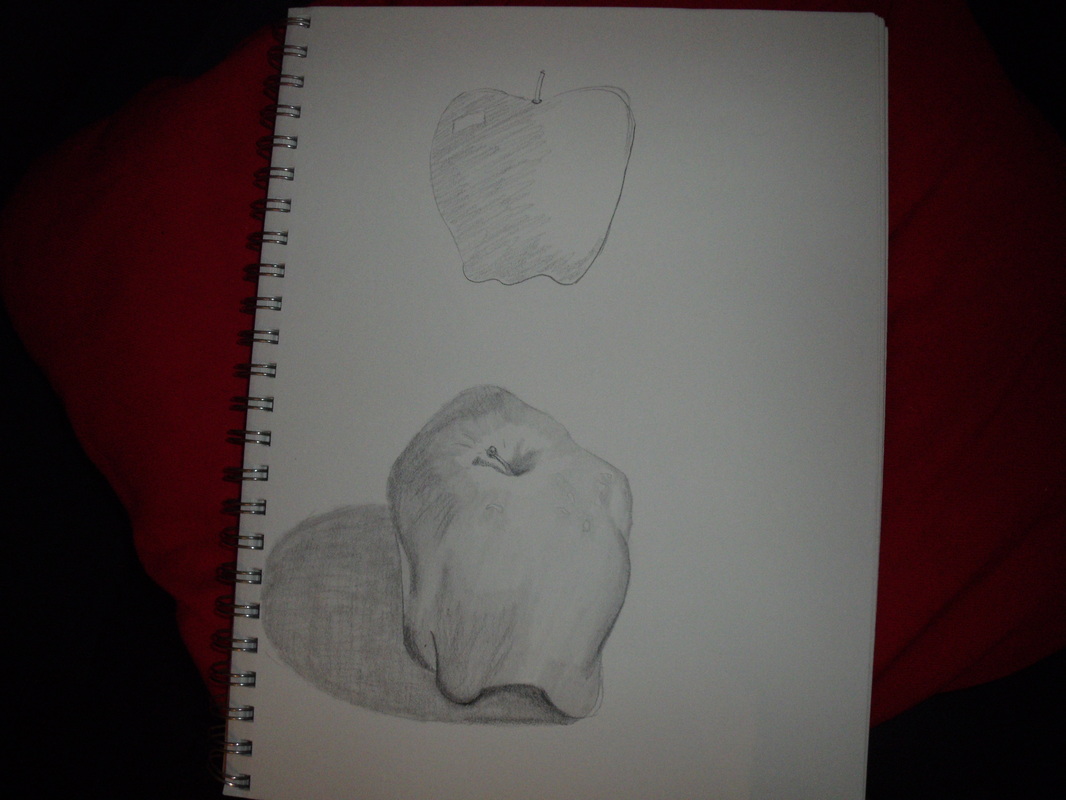
It was a pretty lumpy apple.
Next I studied the spinning book. The next chapter will actually involve spinning, but this one weighed the pros and cons of spinning with a spindle vs. a spinning wheel. Some types of spinning wheels allow you to draft the fibers in different ways, so that you can make a wide variety of yarns. Some are faster than spinning on a spindle. Spindles are better for very fine yarn, are easier on the hands, and are more portable, so you can spin just about anywhere. I think my spindle's great (although I'm planning on buying a smaller one for finer yarns) but I don't have any plans to buy a spinning wheel right now. They're not bad, they just aren't what's going to work for me right now.
Finally, I worked on my embroidery. I'm almost finished my sampler, and I worked on a particularly tricky stitch today: shaded satin stitch. I didn't get the shading quite right so it still looks like I did the darker color in a straight line (it was actually jagged). But I'm just learning so I'm not going to sweat it. Here is a photo, and you can see some of the other circles with other stitches that I've done.

The shaded satin stitch is the one in the middle of the hoop.
My studies are coming together. More slowly than I would like, but they are happening. My husband says I need to give myself some grace. I just read an article about how artists produce better work if they take their time and do other things that they enjoy, so I need to remember that.
Yesterday we watched an Art:21. The theme was humor. All four artists used an element of humor in their work. They weren't necessarily laugh-out-loud funny (although sometimes they were) but humor was a starting point. My favorite artist in the episode did beautiful paintings of Audobon-style scenes of wildlife, but with something disastrous going on. One painting featured a branch full of passenger pigeons, stealing each other's eggs and mating and stuff. But the branch had fallen off the tree and was about to crash into the ground. That sort of thing. My favorite quote from him was "I just want to paint a sexy monkey."
I listened to an Art Biz Blog podcast the other day, and it was about taking out things from your workday that weren't working anymore so that you could add something else in. I was dismissive of the idea when I first heard it but now I think it's something to pay attention to. We really only have so much time, and sometimes things take a lot longer than we think they will. So we need to allow ourselves the time to do the most important work in.
I watched another podcast today. It was a lecture by an artist who works in very small, detailed embroidery. His "patches" were usually about 3 inches squared. His work was very high quality. It must take a lot of time and practice to learn how to embroider that well. He said that in a very productive year he could produce 10 of them, but it was usually less than that. He did scenes from his life, such as things that inspired him about his backyard (I don't know many people who love their backyards as much as this man did!), or a reflection on his grandmother, things like that. It's kind of nice to see artists celebrating the mundane, the everyday, as a blessing.
I got a book on spinning out from the library. I spin a little but I'm not very good, probably because I haven't done very much. Also, I have a spindle rather than a wheel, and most spinning books are about using a wheel. I don't have the money or space for a wheel at this point in my life, so I'd rather use a spindle. Anyway, this book, Respect the Spindle, by Abby Franquemont, is about just that. I have been reading about the author's spinning journey and about different types of spindles. I learned why I have trouble getting thin yarn: my spindle is too heavy and the yarn will break if I make it too thin. So I might want to pick up a lighter spindle eventually.
I have been working on drawing from imagination for the past few days. It's an exercise from Burt Dodson's Keys to Drawing with Imagination. I got this book and his original Keys to Drawing from the library. The exercise I'm working on is called doodling and noodling. First you doodle a shape, quickly and spontaneously. Then you fill in the shape with some kind of decoration which is some kind of meticulous pattern. I spent a few hours on this. I thought it would be a fifteen minute exercise, but I listened to three albums' worth of music while doing it.
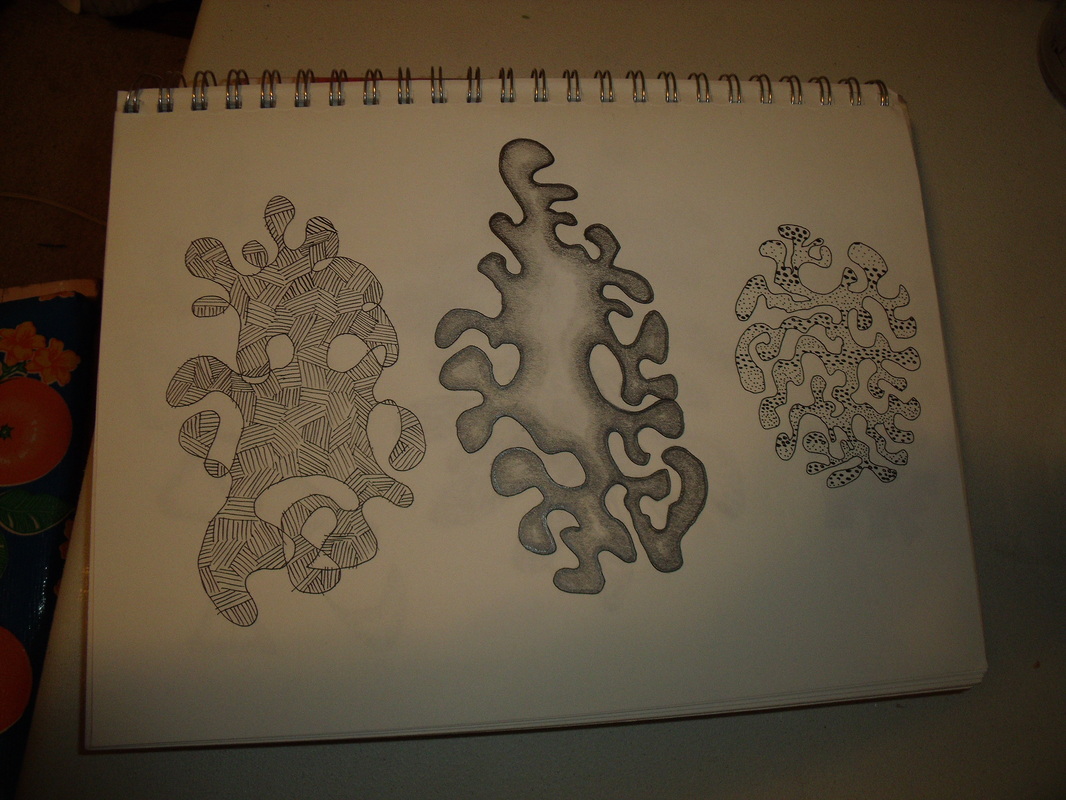
From left to right: patches, shading, and dots.
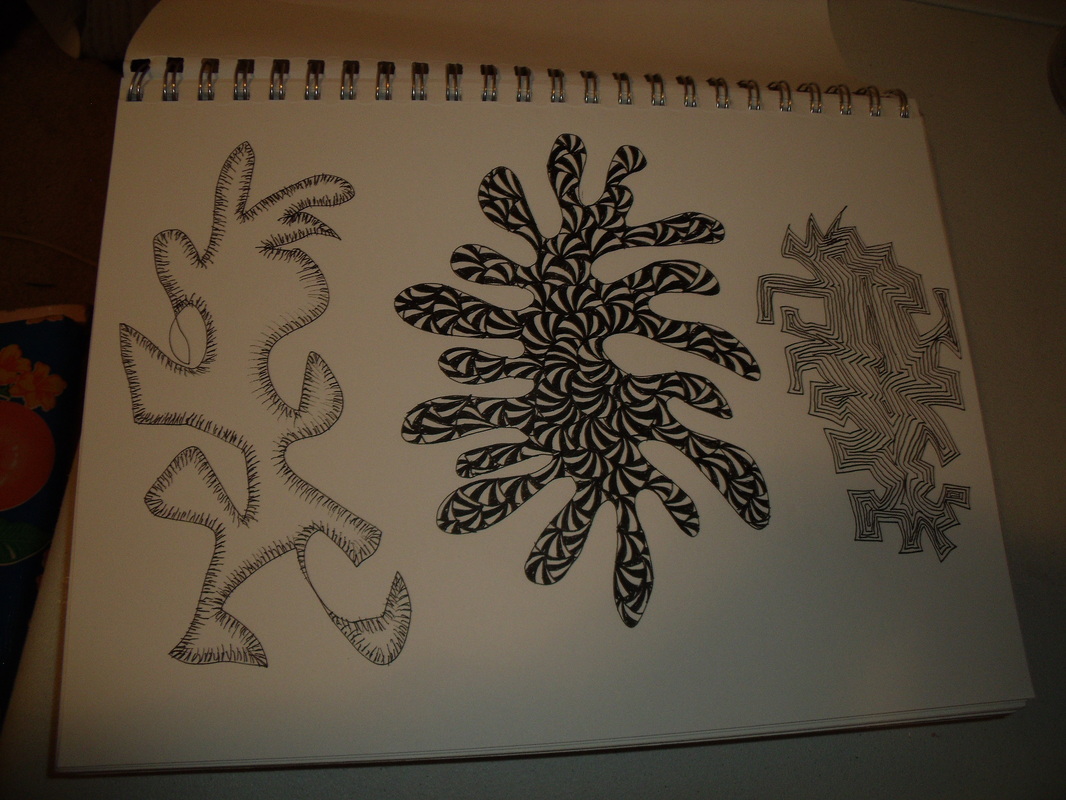
From left to right: cactus, pinwheels, and concentric.
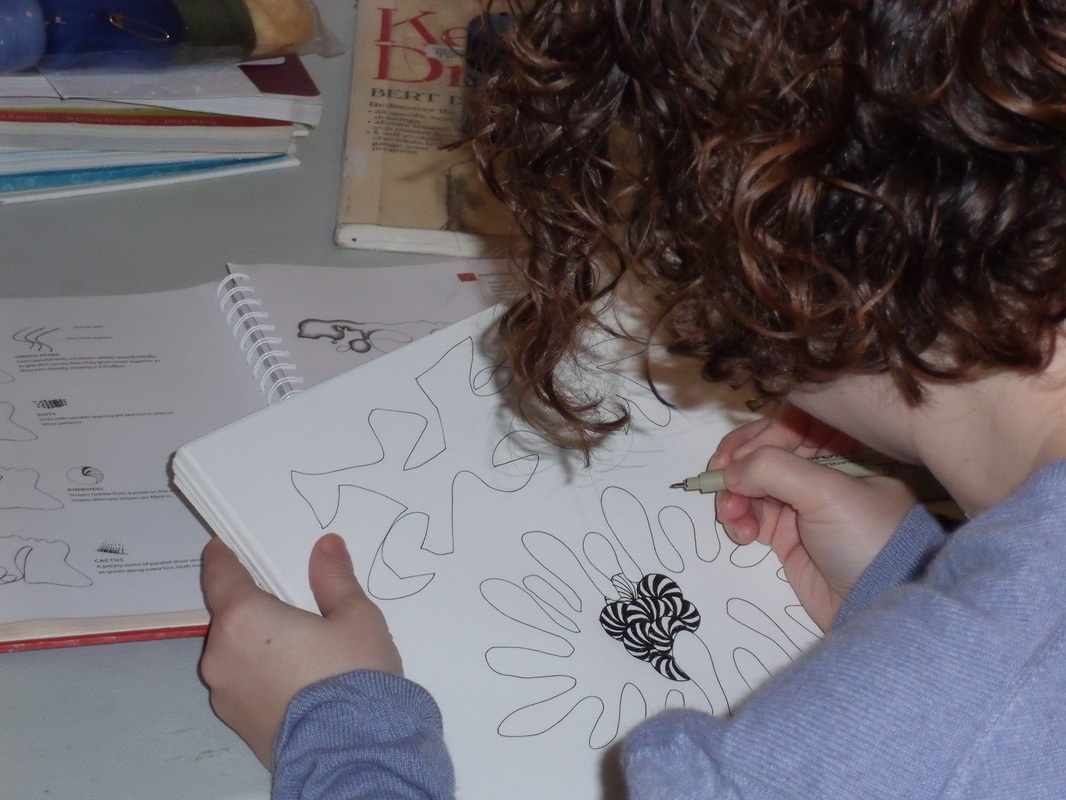
A rare photo of me working.
I think my next drawing assignment will be from the observation book. It will take a half hour of sitting still so I need to block out some time to do that.
I haven't done any work on surface design in the past few days because I'm running out of supplies and don't have the chance to replenish them quite yet. I have a bit more to do before I'm totally out though, so I'm hoping to get back to that tomorrow.
Also, I'm helping another artist who is doing a project on illness. I'm going to write my illness (bipolar disorder) on some vellum tags with my thumbprint on them. Then I'm going to tell a story about overcoming my illness. She's going to collect these tags from many people and put them in glass bottles, I believe. In any case I'm glad that I'm helping another artist.
I'm also continuing work on the panel for a blanket that I'm knitting that will end up being sewn with other panels and distributed to the homeless. It'll be a scramble trying to finish it on time but I'm working as hard as I can on it.
I did a little learning in spite of myself this week. I heard an interview on NPR with Chuck Close, who is a pretty famous artist. Chuck has a condition called face blindness. He can't recognize faces. He forgets names too. So if you go meet him and you met him before he won't know who you are, even if you're his mother. In fact, he can't even recognize his own face. This has influenced his art. He paints faces. What he does is he takes a photo of a face. Then he draws a grid over it. Then he chooses a giant canvas and draws a grid on that. Next he carefully copies the details in each grid of the photo onto the canvas, while increasing it in size dramatically. Finally, when the whole face is finished, he can actually see the face. He does faces of people who are important to them so he can see their faces. Now, if that same person came into the studio right then, he still wouldn't be able to recognize them, but at least he can see, from the drawing, what they look like.
My drawing books have finally come in! I've taken a look at them and they seem pretty good. I'm almost out of dyes and can't buy more at the moment, so i suspect that I'm going to have a lot of time to work on my drawing.
I have completed my first semester of my UnBFA, and it totally didn't go how I expected. But that might be a good thing.
I set out an educational plan at the beginning of the semester. First, I wanted to teach myself surface design. I am proud to announce that I have achieved my goals in that regard. My work is very much improved, and people seem genuinely impressed when I show it to them. I get a lot of joy out of what I make. Through practice, I have grown so much as an artist. It's really weird for me to be tooting my own horn like this, but damn, I'm getting better! I can't wait to see what the next few months will hold as I continue to grow.
I finished my design book. There weren't as many practice opportunities as I would have liked, but I am starting to see the principles being applied to my work. My skills have improved enough that I can actually explore different ideas, particularly in form and color. So that didn't quite go how I thought, but it certainly has changed my work, and I think it's for the best.
I didn't get to work on drawing as much as I would have liked. However, my drawing did improve. This is partly due to the study of value in my design book, and partly due to having the tool of a blending stump. I did not learn to draw from imagination (something I am currently weak at) but I will continue to work on my drawing from observation, at least for a little while.
I didn't get to Art History at all! Fortunately I studied it a bit in high school, so I'm not completely clueless.
I didn't finish those business books that I intended to read. I had to actually run a business, though. I watched several Art of Photography podcasts, which did improve my photography a little. I listened to Art Biz Blog podcasts and read some of the website. This site is tremendously helpful and I hope to continue to study it. I learn something every podcast or blog post. Also, I am happy to announce my latest development in my business: I'm going to be in the Crafty Underdog craft fair! It will be January 8th. It's not a lot of time to prepare and I'm going to be scrambling trying to come up with displays and business cards and stuff, but it's a start. I'm also working on three large commissions that are consuming my time and energy. They are sort of like term-end projects. Very exciting. Furthermore, I am working on my first series that is intended to be more on the art side of the continuum and less on the craft side. I am hoping to get into a show, somewhere, sometime. So this business thing is going somewhere.
I did not get to go out to galleries and see as much art as I would have liked. Practicalities of life made this difficult. I did make it to one excellent lecture and one mediocre one (albeit with great art) and am keeping my eyes peeled for more. I have gotten to volunteer at the Museum of Contemporary Craft a few times now, and I'm making great connections there and learning some of what it takes to run a museum (it takes a whole lot!). One of the advantages of volunteering is that I also get to see the exhibits.
I am also taking it upon myself to improve my hand embroidery and am looking for a way to learn tatting. I'm not yet sure how I will incorporate these things into my work, but I am sure that they are important!
I am starting to form plans for next semester. I will have to continue to study surface design and am going to try my hand at some small shibori projects. These will involve stitching a design, pulling the thread tight to bunch the fabric, dyeing it, and then undoing the thread to reveal a pattern. I will have to do this on small pieces at first because it will take me a year if I try to do it on a tablecloth or something. Additionally, I'd like to work on my weaving a bit. I've only woven one project on my loom (due to lack of funds for suitable yarn) and would like to continue to practice. I need to learn to dress the loom by myself, which is a little daunting but I've done it twice now with supervision. So I will try to hunt down some yarn that will work.
In drawing, I need to actually get that drawing book out of the library and practice more. I might continue to work on drawing from observation for the time being and learn to draw from imagination in a future semester. Hopefully I will also be able to study art history this semester, but my focus will probably be on other things and I might have to let this slide a little longer.
Business study will continue unabated as I learn to run my business. I think it will be much the same, bopping around finding what I need and then implementing that.
I will also be taking my first "continuing education" class this semester. Really, it's just an hour or so class that cost me five dollars, and it's not even fiber-related, but there you go. It's something and it's getting me out meeting people. I will continue to listen to various podcasts (I probably have hundreds of hours of podcasts now) to learn more about the art world. My husband has also tracked down episodes of Art:21 online, which is a great series and very educational in contemporary art.
So, that's my end of semester report!
Here are some more photos of what I've been working on. Some of these are for my brother and my sister-in-law, and some are for inventory purposes.
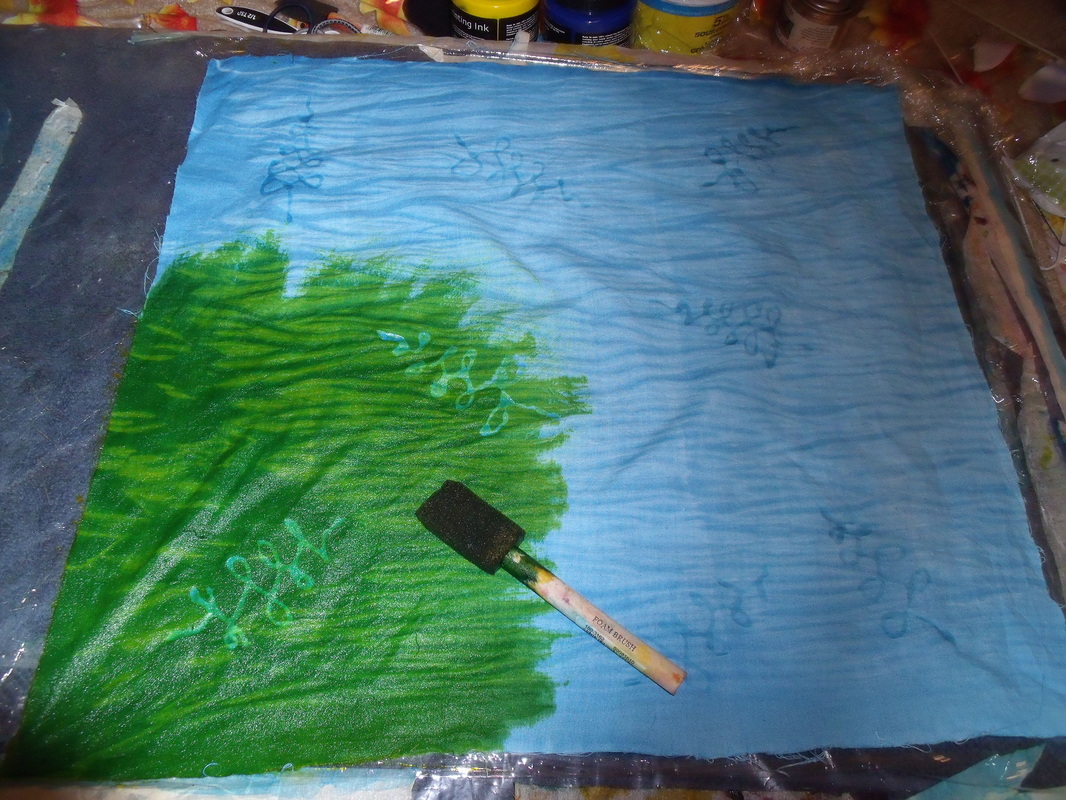
Painting yellow dye over the resisted cloth. It should turn out more yellowish when it's set, but it will still be a bit greenish.

Printed.
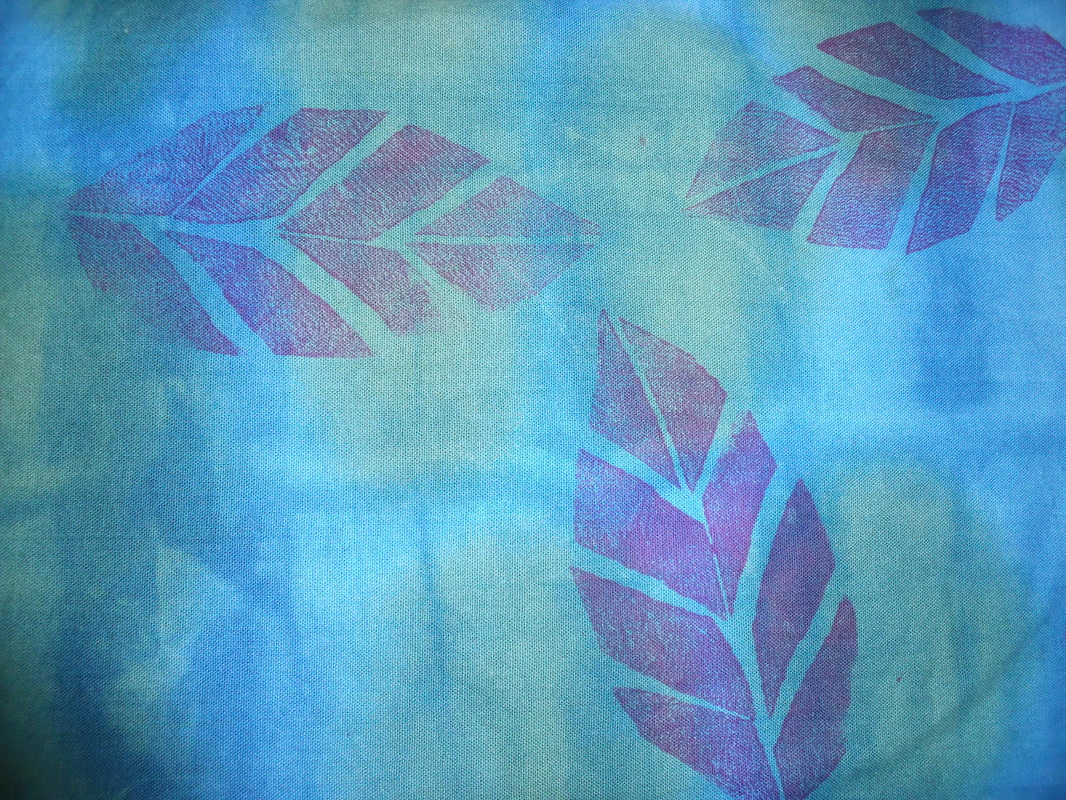
Printed. With the weirdness of the dye, I think this one is pretty much finished.
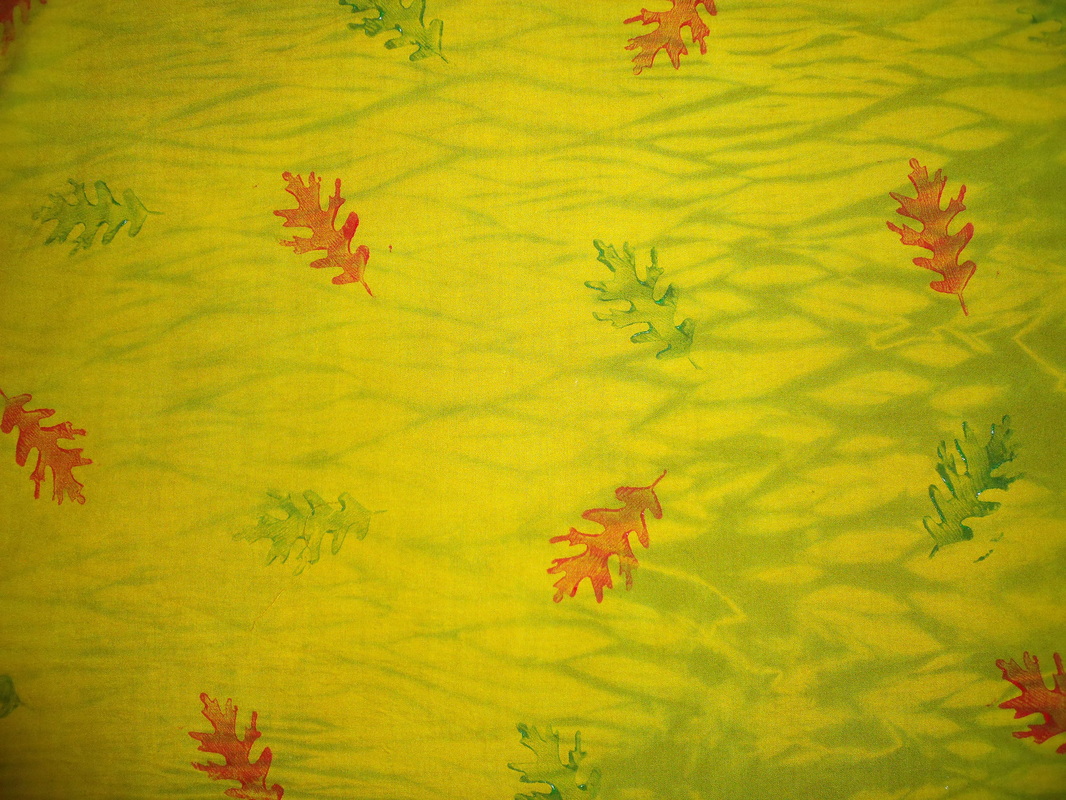
Printed with fall colors.
I have had a few snippets of time to work on schoolwork, although not as much as I would like. Here is what I've been working on.

A warmup in which I altered a photo by dampening it, then coloring with water-based markers.
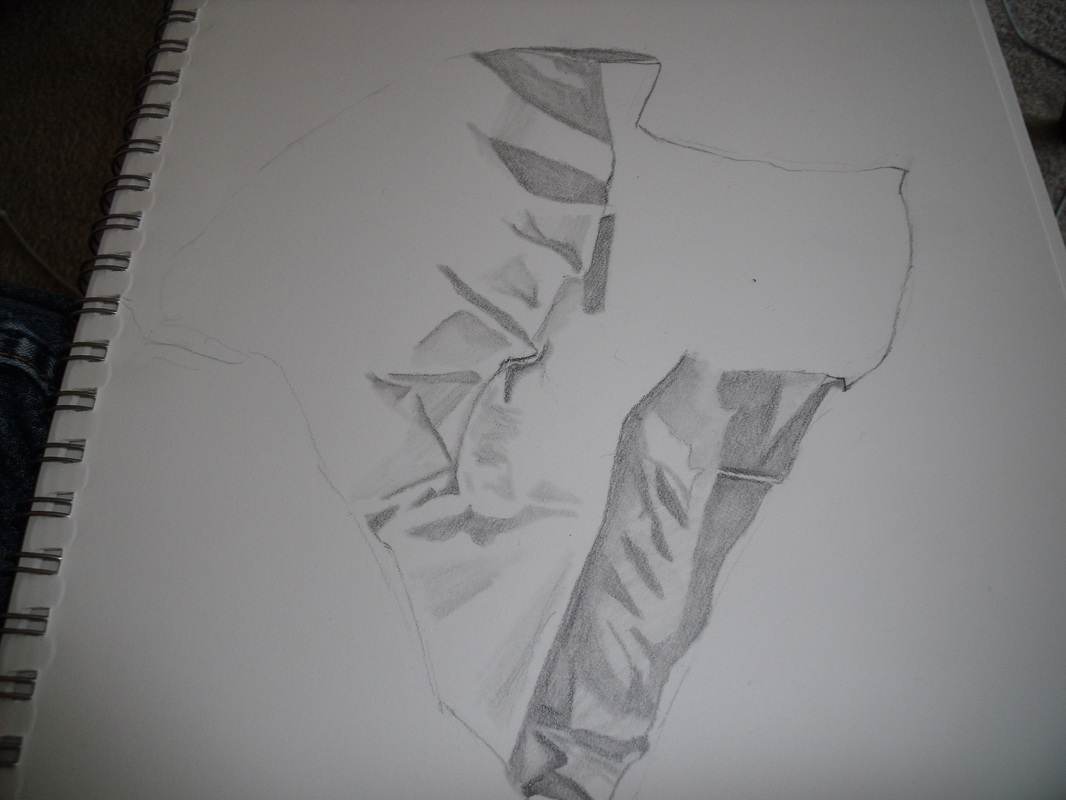
Beginning of my crumpled paper drawing. I need to keep working to make it look like paper and not cloth.
Day 21 took place over a number of days, as I've been sick with a nasty cold recently and haven't always had the energy I needed to do all my work. But I chipped away at it and this is the result. The information I am presenting is not in the order that I did it, but rather the order I can keep it all straight in my head.
My warm-up was to "listen to what nature was telling me". The book even suggested that I consult a book about nature omens. Now, I don't actually believe that there is a such thing as a nature omen, so I had to make of it what I would. It did occur to me that I don't spend a lot of time just observing nature and appreciating it. The book suggested that I do a visual journal entry about it, but I didn't even know where to begin, so I decided to go out with my camera. I figure that photography can be a kind of a journal, and I am eager to improve my photography. So I went for a walk with my camera and took pictures of nature changing for fall. I particularly liked the red red leaves and the squirrels that were so happy with their acorns.
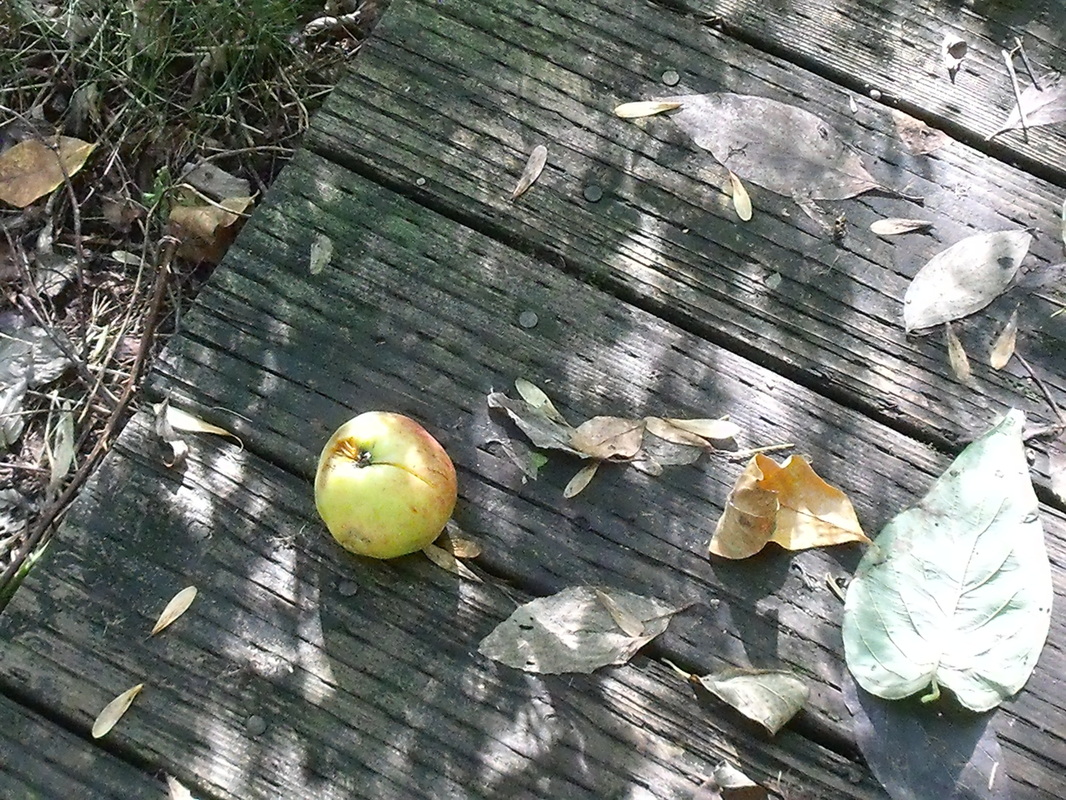
Autumn fruit.

So red!
I watched a fantastic podcast about the Jawaja leather workers of India. They were doing a presentation via Skype, with a translator. Theirs was a very inspiring story. Thirty years ago, they were so low-caste that they weren't allowed to draw water from most of the wells. The traditional way of leather working in India is to scavenge for dead cows, as you're not allowed to kill a cow. So this was a despised profession. The leather workers were very poor. Their elders decided to ban the scavenging of dead cows and work on shoes (feet are kind of taboo in India) in order to raise their status. This had the unintended effect of making it even more difficult financially for the leather workers, as they had to buy processed leather, and couldn't sell as much. Eventually, they decided that they had had enough and began to work with design schools and craft councils. They helped develop products that could be marketed overseas. They began to sell to Maiwa and made enough money that they could eat twice a day (they were eating once every two days before that) and own houses. Since the presentation, customers have been so interested in the leather work that they have had to carry extra stock. Their bags and purses are very popular and they always have a large selection on their website. I was very happy to hear about the improvement of their lives and I hope they become even more prosperous. Their social standing in the village has also improved and now they are allowed to draw from all the wells. I have been working on a drawing of crumpled paper. This is going to take me a few days., I think. It requires a lot of concentration and patience. So far, I think it looks like cloth, but we will see how it looks when I am finished. I will post pictures as I have them. I watched more podcasts on the Art of Photography. The first one I watched was about scanning negatives, and it reminded me of my first full-time job as a digital scanner. It was a good refresher, and I learned about adjusting the histogram more finely than I did at work to improve detail in the photo. The next one I watched was on dynamic range, which is the range of values in a photo. Ideally there should be a wide range of values in order to show the most detail, unless you are doing high contrast on purpose. You can adjust the values in the computer to improve the range. The next one I watched was pretty cool, on tethered shooting. This is where you set up your camera to load pictures directly onto the computer so you can tell if they are exactly as you want them (it can be hard to tell on that little screen). That way you can adjust your settings to tweak the photo. This technique is used especially for catalogue photos. The final one that I watched was on time-lapse photography. It's very interesting because you have to set your camera up to take these photos at set intervals and then not touch it. You can't adjust the lighting levels or anything or it will look strange. There are programs that you can get for your computer that will play the time-lapse and you can make a little video. In my design book, I reviewed the chapters on shape and texture. In surface design, I am proud to say that I have my bolt of cloth! I have spent the last couple of days preparing the cloth and have cut the pieces for the order for my brother. I have also been working on dyeing some other pieces that I was experimenting on, and I am washing out those pieces now. It doesn't sound like I've done a lot but preparing an entire bolt of cloth takes a long time!
Well, I'm feeling pretty sick today, so I'm taking a day off. However, I did stuff yesterday so here's my report. I started out with a podcast. It was by an artist who talked about her commissions. I am doing mostly commissions these days, so I was interested in what she had to say. She sort of built her own fiber art education, since she had studied ceramics in her undergrad and didn't have time to go back and study fibers. She did this by working in a theater costume department. She specializes in wearable art that can be worn by everyday people, not just displayed in a museum. She liked working on commission because she enjoyed the challenge of trying to meet her clients' needs while still being creative. In some cases she has even used a different medium, if fiber wouldn't be suitable. That's something I have to work on: I can do what I can do but if someone asks for something at all outside of that, I get befuddled and am unable to do it. She also had an interesting payment structure, where she collected the payment in thirds: one for the initial materials, one mid-project, and one on completion. I am not sure why you would need the mid-project collection but she said that it was what worked best for her. She also talked about how temperamental her indigo was: you have to harvest and use it at the right time or it won't work at all. One year she missed harvesting it before the frost, and the frost turned all her plants blue. She said it was stunningly beautiful and didn't seem at all disappointed that her crop was lost! Next, I did a warm-up. (Crazy, podcast before the warm-up!) The assignment was to research cultural symbols of a culture that spoke to you. I have been interested in (obsessed with) Indian culture since I was about 14 years old. Now, admittedly, most of this obsession has revolved around food. I went through my Bollywood phase and my wanting-to-wear-a-sari phase and my Ravi Shankar phase and even courted the idea of becoming Hindu for a while, but those were all things I passed through. Food has been the constant, especially vegetarian food (I am beginning to branch out into meat now). So there were actually a number of symbols that I didn't know about, or at least didn't know the importance of. I got my information here. My favorite symbols were the Deepam (a little butter lamp used for worship), the coconut, and the lotus. The Deepam is said to remove impurities, the coconut to bring prosperity, and the lotus, among other things, represents detachment (I believe that's in the Buddhist sense). I reviewed line in my design book. I looked at measure, type, direction, location, character, as well as line and shape, line and value, texture, color, spacial characteristics, and representation and expression. Learn more about line here and here. Finally, I did a drawing of a little woven box that I got some spices in. I didn't get a chance to do surface design yesterday, because the glue resist I had applied wasn't dry yet. If I can rustle up the energy to do it today, I will, but so far things aren't looking so good. I also have received a deposit to go purchase supplies for my next commission, but I think I'm too sick today to go out and get it! Hopefully I will feel better tomorrow and I can hop to it.
Today I finished listening to the roundtable discussion on the working traveler. The travelers were asked what their favorite places were to visit, and most of them had difficulty answering, because each place was so different, and a place could change so much in a matter of a few years. They also talked about how they financed their trips. It was very interesting, because none of them were rich, but they rearranged their finances so that they could travel. It was the most important thing to them, so it was their priority. They talked very little about fiber arts at this stage, but it was interesting to hear about how they managed to travel. I hope to travel more in the future (when I have finances to rearrange!) but I don't think it will be a priority for me.
I drew some shells. I am pretty happy with how they turned out. I loved all their little ridges.
I worked on rinsing out my brown dyes from yesterday. I haven't finished rinsing them yet so I'm not sure how they've turned out. I also worked on painting with some orange dye, and doing a pole wrap and a tie-dye with the leftover dyes. I don't have pictures yet but I will post them as soon as I have them.
Short post today! Hope you enjoyed!
Today, I started with a warm-up to research an artist's life. The artist suggested was Frida Kahlo, which suited me fine. I'm not a Frida Kahlo fanatic, but I do like her work. Anyway, I discovered that the movie pretty much told it like it was. There were a few things in there that I didn't believe, like that she had an affair with Trotsky. Well, at least according to Wikipedia (how academically rigorous, I know) it's all true. She really was bisexual and her husband, Diego Rivera, really did have an affair with her sister. She wore long skirts because she had polio when she was a child and it deformed one of her legs. The bus accident she experienced as a teenager caused her pain throughout her life and she was frequently bedridden because of it. She became an artist after the accident (she was self-taught) and painted until her death, at age 47.
I listened to the next part of the roundtable discussion that I have been listening to lately. It was a response to audience questions, and there wasn't too much pertaining to fiber art, but more to do with traveling. They had some real horror stories about some of their travels! But there were a few important nuggets to learn, such as that unprocessed fiber isn't allowed through customs in the United States (good to know, in case I visit some sheep farms) and that there are in the world warehouses full of exquisite embroidered and woven textiles that get cut up for use in patchwork that is sold to westerners. Also, there was a plea for people to buy fewer clothes and make sure the clothes that they do buy are fair trade and, if cotton, organic, and made of natural fibers, because there is such waste in the world of textiles. This jives with my own thoughts about how people treat clothing. Some people throw clothing out. Did you know it can be reused, even if it's not wearable anymore? Old clothes are used for rags, new garments, patchwork, quilting, and rugmaking. Often clothing can be saved with a patch or some darning or a good stain remover. So think about that next time you are tempted to throw clothing away!
I drew a vase. Not much to say about it. My drawing was a little better than last time. I wonder how much of that is because of the practice of the last one and how much it was because my ceramic was matte instead of shiny. My vase sides are getting more even. Those of you who do not draw or paint, you don't know how difficult it is to get even sides on vases and bottles. Even arches are difficult. Usually they come out lopsided. This one is considerably less lopsided than my usual vase drawings, so I am happy about that.
Yesterday, I washed out all my cloths. I discovered a new technique to getting the dye out without bending over it for an hour: let it soak in several changes of hot water, for about half an hour or so at a time. It worked wonderfully and I was a lot less cranky than I usually am with the process. Today I ironed them and added a glue resist to most of them. I am working on a sample for my brother and sister-in-law as well as some bookmarks. I prepared some more bookmarks for dyeing, but I didn't have enough to bother with making up some dye today. You have to use all the dye in the same session that you make it, or it won't work, so it's not worth it unless you are actually going to use it all. I would only need about a quarter of a recipe, which is too fiddly to bother with. When the resists are dry on the rest of them I will dye them all together.  First-batch dyed cloth with school glue resists setting. The two blue ones in the corner have already had glue resists washed out of them.  Close-up on bookmarks. From left to right, they have been tie dyed (first two), pleated, pole wrapped, pleated (next two) and pole wrapped again. 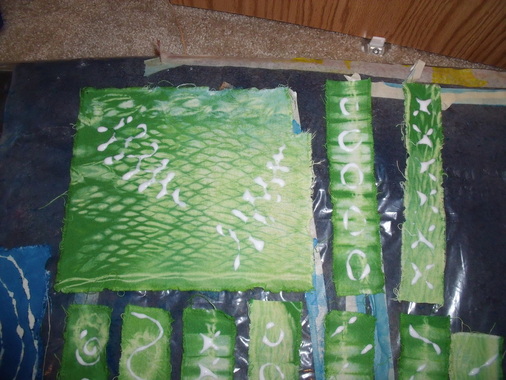 Sample and two more bookmarks. From left to right, pole wrapped, pleated, and pole wrapped again. I also designed this stamp to block print with. I modeled it on an oak leaf.  Sketch for the stamp. Oak leaves are pretty easy to draw, at least they are if you are doing a contour drawing like this.
|

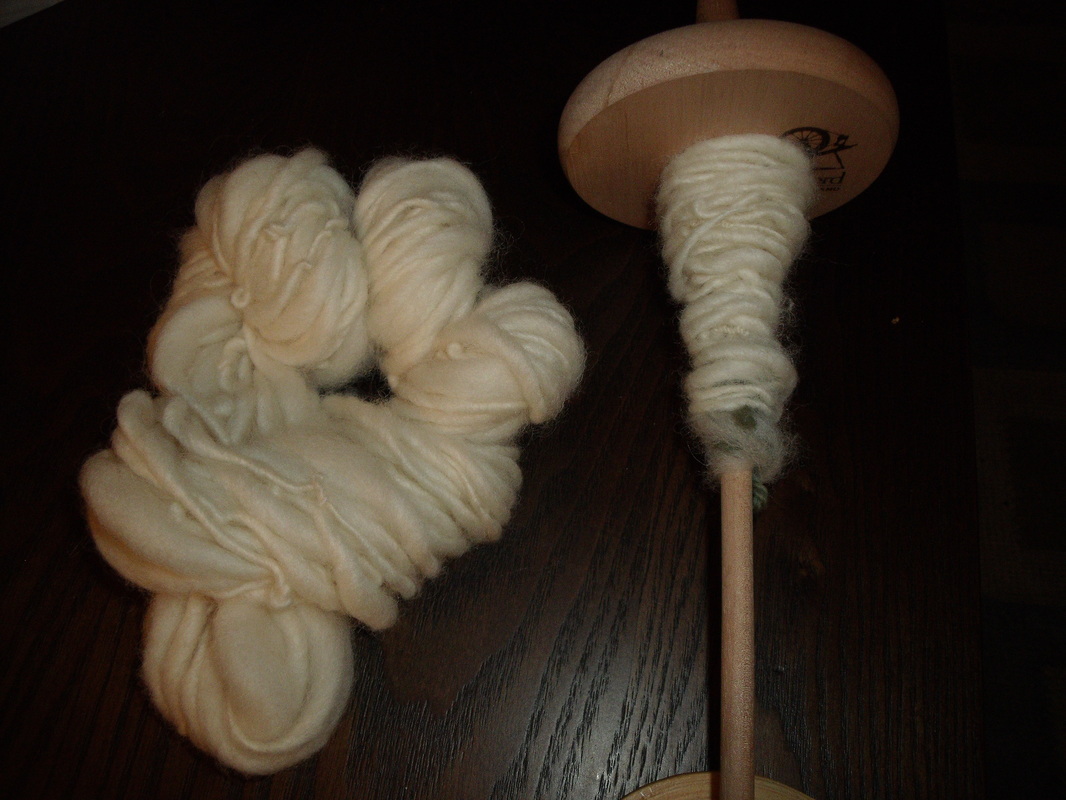
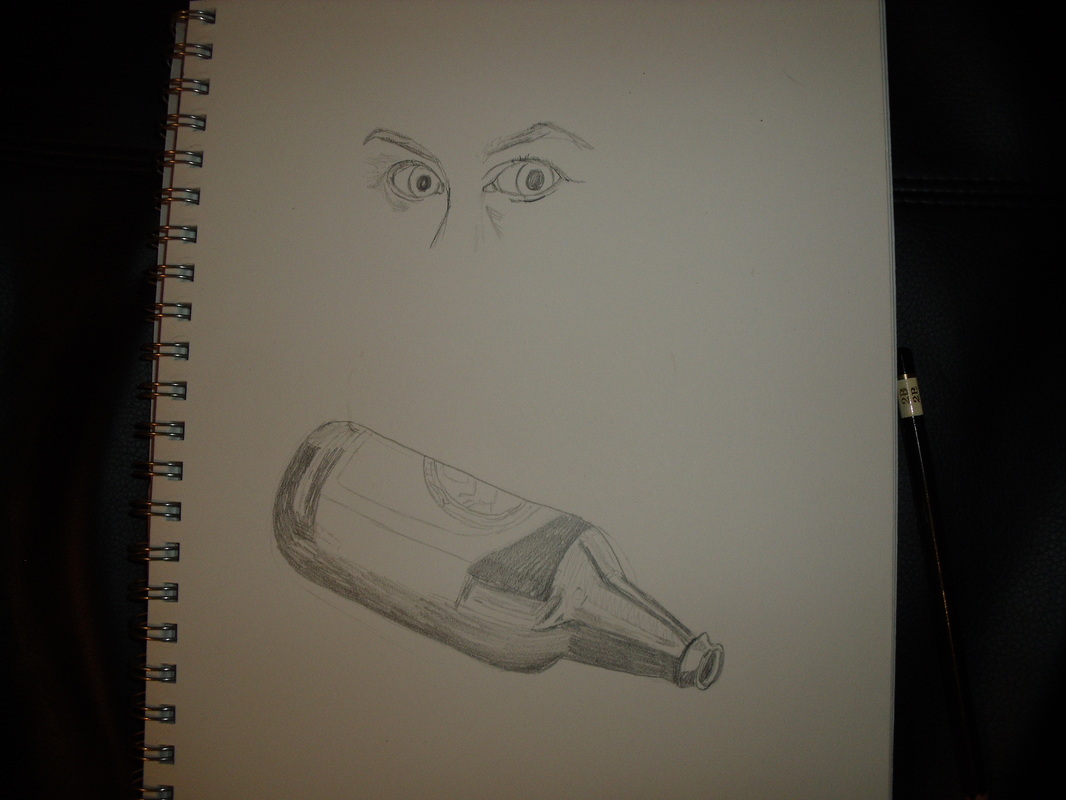













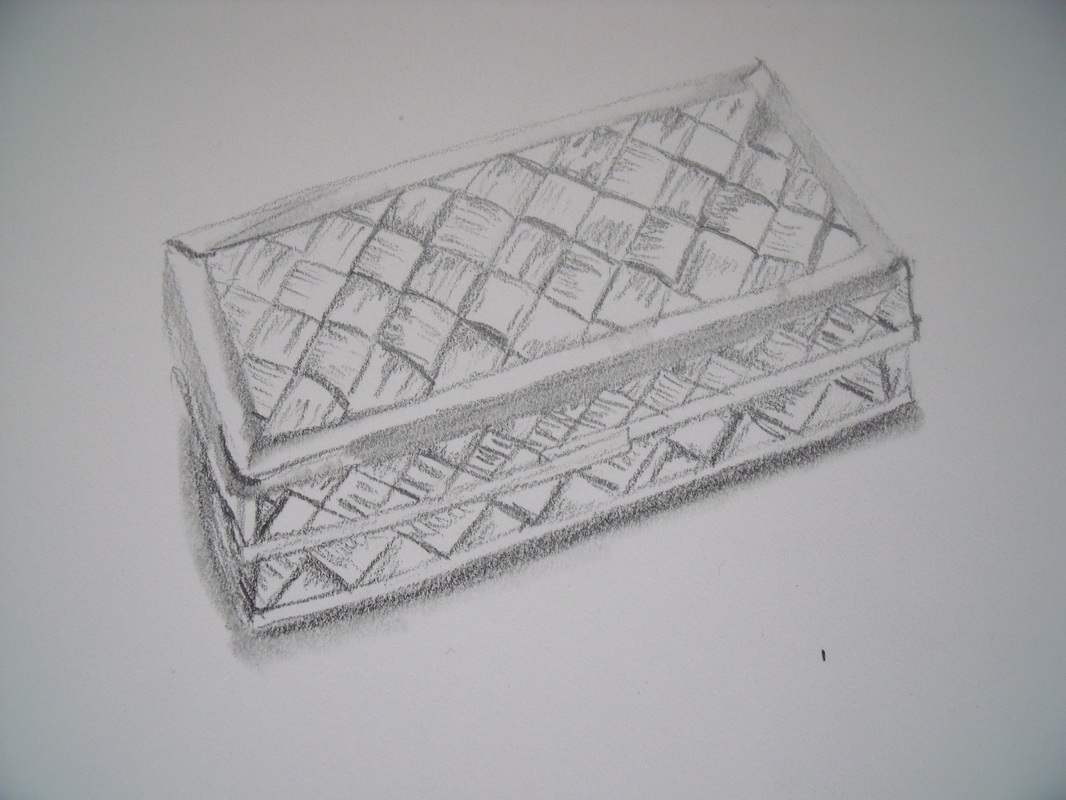
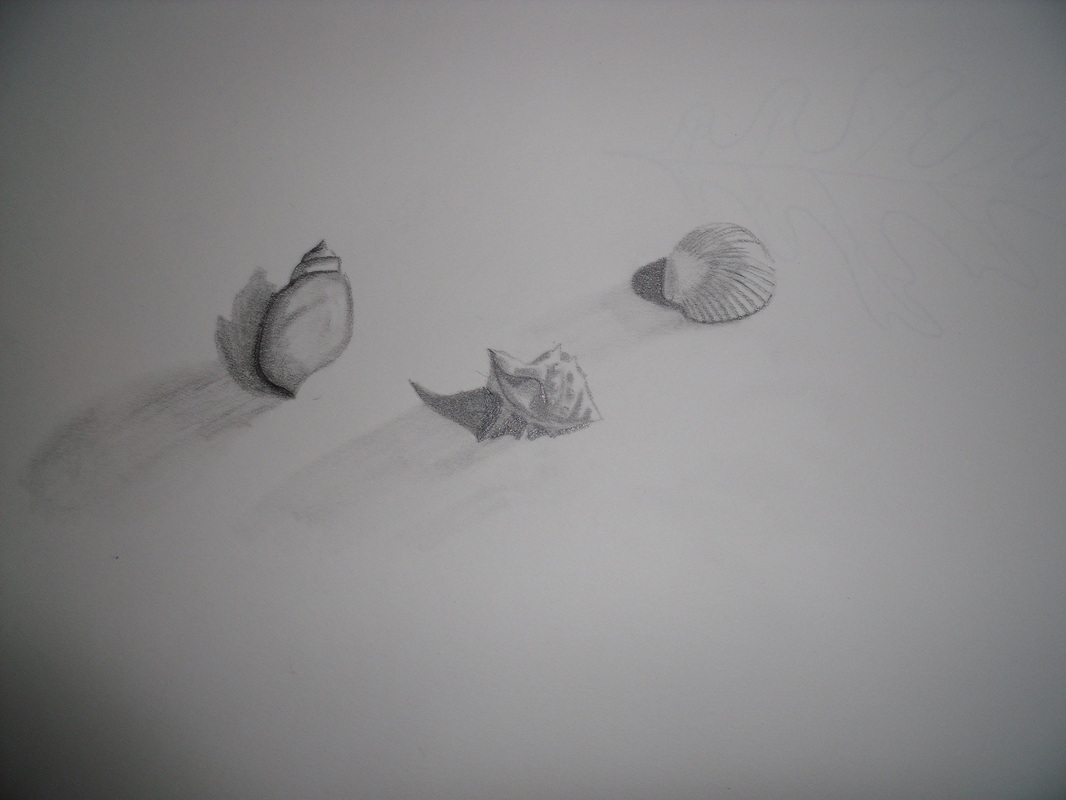
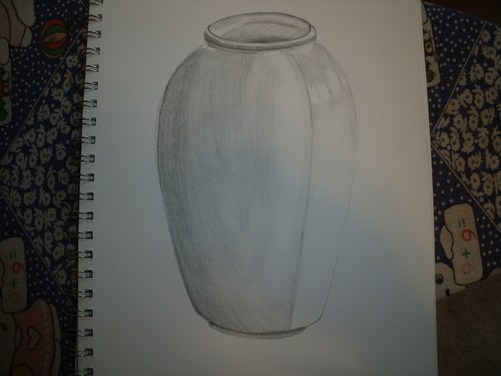





 RSS Feed
RSS Feed
